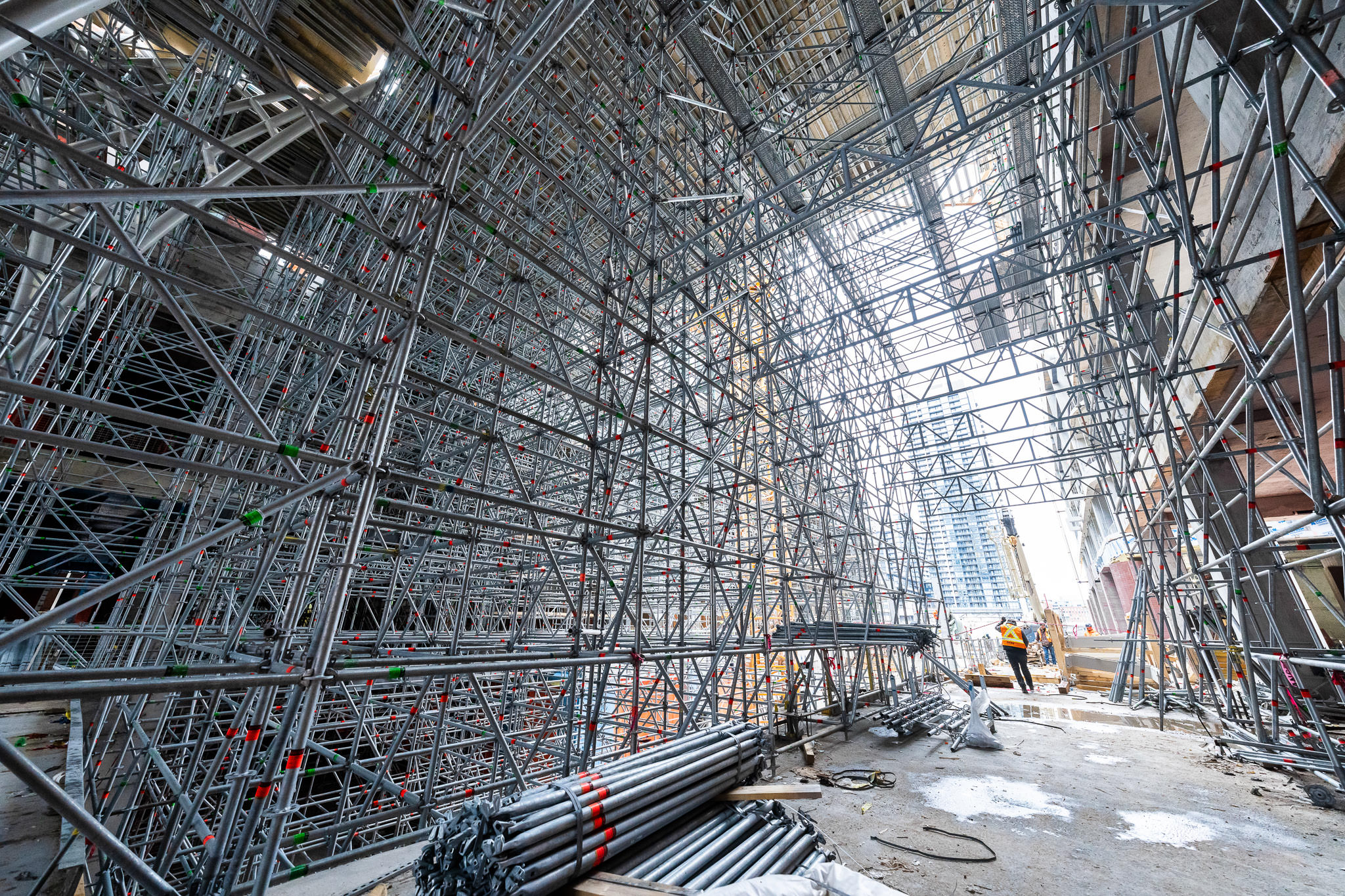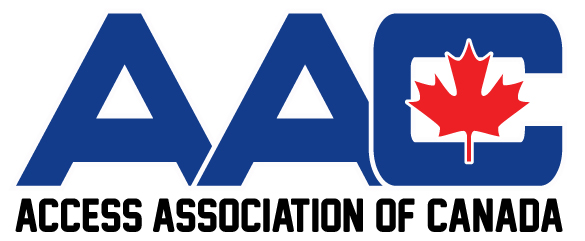
Industry Resources
Types of Access Equipment
Learn about the various types of access that are used in Canada:
System Scaffold
A scaffold can be generally defined as a temporary structure supporting a platform positioned at an elevation above the ground. Its purpose to provide a working surface to support workers and their necessary tools and material.
A scaffold must have at least one platform and can be supported from the ground or suspended from overhead supports.
A system scaffolding structure is essentially a frame structure utilizing a specialized modular connection and has evolved from the general principles of tube and clamp scaffolding The major difference between tube and clamp scaffolds and system scaffolds is the connection of the uprights -“standard”- to the horizontal members -“transoms and ledgers”- and the diagonal members -“braces”-
The connection between the transoms and ledgers and the standards is normally by a specially designed mouth piece and rosette device or by other modular connection methods. The connection device is also used for the connection of the various diagonal members or braces.
Suspended Access
Suspended access could be described as a suspended platform varying in size from 1 metre to 12 metres in length that is suspended from permanent or temporary supports on the roof of a building or other structure. Modular platform configurations allow for maximum flexibility and easier storage for both the end user and the supplier. Depending on the length of the platform, the manufacturer, and the powered hoists used, suspended platforms can have capacities as high as 680 kg.
Suspended platforms can have manual, air-powered, or electric lifting devices to allow a platform to be raised or lowered up the sides of a building, chimney, boiler, or any other elevated structure.
Suspended access is typically used by: window washers, restoration contractors, window installers, caulking contractors, or any other trade where elevated access is required.
Relevant Resources:
CSA Z271:20 – Design of suspended access equipment
Z91-17 (R2022) – Health and safety code for suspended equipment operations
Fall Protection
Fall protection is, by far, the greatest safety challenge for erectors and all types of scaffolding and access systems. Over 70% of all scaffold related fatalities are falls from the platform or access. In addition, the use of most personal fall arrest systems (PFAs) for scaffolding represents even greater challenges. PFAs used on scaffold and access devices must contend with difficult issues such as: anchorage, freefall, swingfall, energy absorption, obstructions and impalement hazards.
Guardrails are by far the most common and effective fall protection tool for supported scaffolds, however, they are not an easy solution for scaffolds while being erected or dismantled or even for other access systems such as: swingstage scaffolds and powered elevating work platforms.
The SIAC Fall Protection Committee is dedicated to working with the SIAC member firms and affiliates, such as regulatory and standards agencies as well as fall protection equipment manufacturers to develop and communicate fall protection “industry best practices” for scaffolds and access systems.
Shoring
Shoring is the process of supporting a building, vessel, structure, or trench with shores (props) when in danger of collapse or during repairs or alterations. Shoring comes from shore a timber or metal prop. Shoring may be vertical, angled, or horizontal.
Frame Scaffold
Tubular metal frame scaffolding systems are probably one of the most commonly used scaffold system in the construction industry. The scaffold consists of welded steel or aluminum frames connected by cross braces to orm a framework to support scaffold planks or other scaffold platform systems.
Frames are manufactured in a wide variety of sizes and configurations, the most common being a standard 5 foot by 5 foot frame and walk-through arch or arch frame
The arch frame scaffold is very common in the masonry construction sector as it allows convenient movement between the frames for distribution of materials. Outrigger brackets or side brackets can be installed on the side of the scaffold at varying levels to provide a convenient personnel platform for work at the building face.
PEWP
The first portable scissor type platform was developed in the early 1800’s as a method of spotting artillery hits and enemy positions. This towable devise was brought by horses into the field and elevated and lowered by a manual crank. Internal combustion engines were added in the 1930’s and battery power became a standard in the 1960’s.
The first boom type platforms were developed for the agricultural market, hence the term cherry picker.
From these beginnings the boom type and scissor type powered elevating work platforms have virtually become a tool of the trade on construction sites in North America. Tens of thousands of these devices ranging in heights from 15 feet to 150 feet are employed in Industrial and Construction environments every day.
These devises are regulated, in Canada, by the CSA B354 family of standards. These standards cover material, manufacture, and test criteria, as well as maintenance and operator training requirements.
Mast Climbing
Mast Climbing Work Platforms (MCWP) also known as mast climbers are a mechanized modular scaffold system that consists of one or more vertical mast columns and a mechanized platform that climbs the mast column to position the platform vertically as desired. The platforms are primarily used to position workers, their tools and materials at elevated work locations.
Key Components
Mast sections- Vertical members that comprise the structural mast column. Typically, these are modular and approximately 1.5m in length and support a key component of the driving mechanism.
Platform modules- Horizontal modules that make up the MCWP’s platform deck. The modules are bolted/pinned together to create the desired platform length. The platforms permissible length is dependent on the particular model/design.
Drive/power unit-The structural component that the platform modules are connected to and it houses the mechanized drive that propels the system vertically. The drive is typically powered by an electric motor (s), gasoline engine over hydraulics, or air motor.
Tie systems- Are the structural members used to tie the mast column back to a structure to provide stability to the mast column. The requirements for tie spacing are established by the manufacturer for the specific model.
Bases- The structural component that supports the mast and transfers the vertical load to the supporting ground or structure. There are several types of bases; a) mobile bases- chassis or trailers that provide mobility to the MCWP. The chassis may be powered to provide additional mobility. b) static bases- pedestal, ground frame, plates.
Materials cranes- Mechanical devices to facilitate the movement of materials to/from the platform while it is in an elevated position.
Mast Installation cranes/jibs- Mechanical device to aid in installing the MCWP’s mast modules.
Advantages- MCWPs
- have high capacities relative to suspended systems
- require less labour to install, dismantle and relocate than conventional scaffold
- provide an ergonomical environment that allows the worker to be more efficient
- combine material handling in addition to access
Relevant standards
- CSA 354.9 Design, Calculations safety requirements, and testing methods for Mast Climbing Work Platforms
- CSA 354.10 Safe use and best practices for mast climbing work platforms (MCWPs)
- CSA 354.11 Training for Mast Climbing Work Platforms (MCWPs)
Training
Are you interested in joining the scaffolding industry or want to update / upgrade your skills? We utilize training programs through our alliance with the Scaffold & Access Industry Association.
Available programs include:
- Competent Person (CPT) for Supported Scaffold
- Competent Person (CPT) for Suspended Scaffold
- Mast Climber Operator
- User Hazard Awareness
- Scaffold Erector Apprenticeship
- Journeyman Scaffolder Challenge Program
- Online Training is also now available!
For more information visit them online or contact them at 816.595.4860 or info@saiaonline.org for more information.
